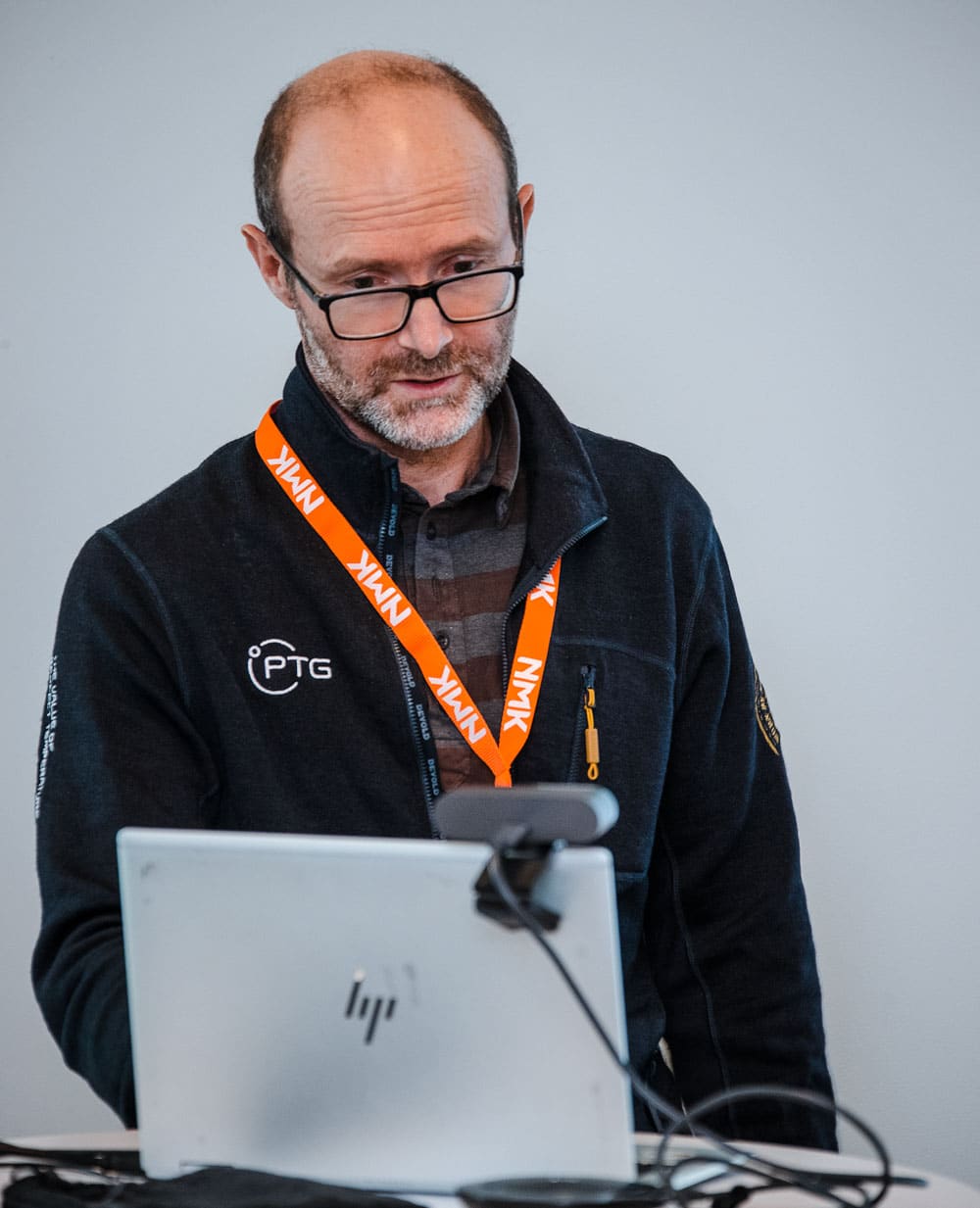From left: Kristina N Widell at Sintef Ocean, Frode Berg, technical manager, PTG, and Yves Ladam, development manager, PTG, at the CoolFish meeting in Ålesund during September 2022. CoolFish is a research project with funding from the Research Council of Norway.
A project aimed at finding refrigerant alternatives to R22, ammonia and hydrofluorocarbons was the starting point for extending CO2 to the maritime sector. Pursued with the Norwegian University of Science and Technology (NTNU) and its Sintef research arm, this work targeted coasters/fishing vessels with capacities up to 500 cubic metres. “Customers have many different motives for seeking such options, and we’ve tried to respond to them all,” says Yves Ladam, development manager at PTG.
He was clear enough about the group’s motivations when presenting these solutions to an attentive audience at the recent CoolFish meeting in Ålesund.

Development manager Yves Ladam at PTG presented the group’s CO2 solutions to an attentive audience at the CoolFish meeting.
Ladam noted that a number of customers were reluctant to use ammonia because it is toxic, and many also lacked the space for a separate engine room. Another motivating factor for those involved with HFC-R22 systems was problems posed by expensive leaks.
SeaCo2ol RSW
These considerations prompted PTG to begin developing an alternative approach, which reached the prototype stage in 2010. It was initially intended to replace R22 installations, but a full product range called for further research and development work lasting until 2016.
In his presentation, Ladam reviewed the group’s journey since launching the project and referred to its 240 megawatt facility on Båragutt. This included a flooded evaporator, a specially constructed oil separator and four Dorin compressors.
However, it turned out to be heavy and relatively expensive – as well as complex compared with ammonia (NH3) and HCF options. Work was therefore initiated to cut costs.
The result was what Ladam called the “modern SeaCo2ol” solution for CO2, comprising a low-pressure receiver (LPR) with around 15 per cent liquid out to the evaporator, a liquid ejector and the TEX evaporator from PTG Frionordica. It has a 150 kilowatt compressor but no oil separator, helping to cut generator weight, enhance cost efficiency and reduce complexity. About 40 of these units have been delivered, and more are on order.
SuperFreeze
CO2 can also be used in SuperFreeze plants for fish, and Ladam took the opportunity to talk a little about PTG’s solutions here as well. The group delivers what he calls transcritical CO2 plants to an industrial standard.
These facilities have a freezing capacity of up to 60 tonnes per day, and utilise pump-circulated refrigerant for reducing product temperature on board to ‑50°C.
Asked why PTG believes that customers want such plants, Ladam refers back to his explanation that they want to avoid expensive leaks with other refrigerants and that ammonia is toxic.
“It’s also the case that a lot of them lack the physical space for a separate engine room. A CO2 installation will moreover provide faster freezing and is compact – a feature many want. The prototype for this solution was first delivered in 2014, and can also be supplied in a variant with combined refrigerated seawater (RSW) and freezing.”
He confirms that PTG has also used a classic booster layout in a two-stage plant, with oil return from the ‑50°C tank. “We thereby achieve efficient freezing and defrosting, along with the compact solution offering low maintenance costs. And a natural refrigerant is used.”
Innovation
In conclusion, Ladam mentioned the innovative trawler now being introduced by Ulstein with technology from PTG. Ordered by the Bluewild fishing company in May 2021, this vessel incorporates highly interesting refrigeration facilities – SuperFreeze (500 kW, ‑50°C), SeaCo2ol, brine freezing, individually quick-freezing (IQF) and heat recovery.
Ladam says experience with CO2 plants on vessels has so far been fairly varied. “The demand is for large and stable levels of fish processing. Minor and what we might call trivial problems can create a lot of bother – the threat of leaks means that strict requirements are set for finding the right seals.
“Sourcing components can also be a problem. We use large transcritical compressors, big titanium heat exchangers and so forth. New components may have teething problems, and oil recirculation presents contamination problems. And this is a relatively complex solution, which can be a challenge in itself.”
He also notes that CO2 may be non-toxic but does present a risk of suffocation in certain circumstances, and that PTG takes this very seriously.
“We therefore systematically install two CO2 detectors in both engine room and factory area, along with powerful ventilation systems. Customers also receive start-up training.”
Backstory
PTG Kuldeteknisk was founded in 2003 by Tor Vangberg and Frode Berge with four other former colleagues. It has subsequently been a pioneer in developing environment-friendly refrigeration technology, particularly based on CO2.
Since starting up, the company has supplied its innovative CO2 refrigeration plants with energy recovery to all the large Norwegian grocery chains – including Coop, Rema, Norgesgruppen and Ica.
It went on in 2011 to deliver the world’s first RSW plant with CO2 as the refrigerant for cooling seawater on a purse seiner.
The company won an initial contract covering a transcritical freezing plant for the maritime segment in 2014. That year and next, it built and tested a full-scale pilot facility with CO2 as the refrigerant on freezer trawler Roaldnes for Nordic Wildfish.
CoolFish
Funded by the Research Council of Norway’s large-scale programme for energy research (EnergiX) and industrial partners, the CoolFish project aims to help develop energy-efficient and climate-friendly systems for refrigeration and heat production on fishing vessels.
It is headed by Kristina N Widell at Sintef Ocean and has Sintef Energi and the NTNU as research partners. Industry backers include MMC First Process, Bluewild, Selvåg Senior/Sørheim Holding, Øyangen, Gasnor, Danfoss, PTG — Perfect Temperature Group and Isotherm Inc.
By Jørn Wad

